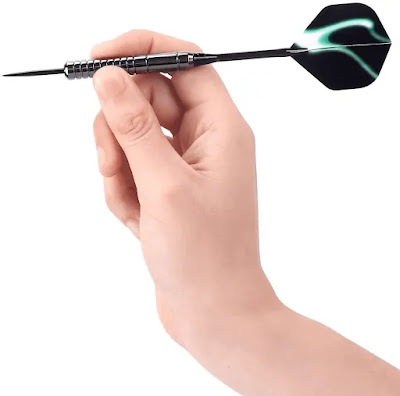Have you seen professional darts? If that's the case, how the pros throw darts so consistently must have blown your mind.You must have been thrilled by how easy they made it appear. However, most individuals don't comprehend how darts fly to the dartboard. Darts don't always fly straight.
A dart follows a parabolic curve. Imagine an oval or the sun's summit. Although barely apparent, the dart glides up and down the curve. Thus, to throw a dart accurately, you must follow the curve.
Since darts fly, this page will discuss them. We'll also teach you how to aim properly and follow through after the throw for the best release. We will also discuss any pertinent information.
Precision of dart flights
As said, the dart ascends the parabolic curve and descends. But if you throw your dart too rapidly, it may fail to follow that curve, and there won't be much precision in your throw. Speed decreases accuracy, naturally.
Yale and Harvard scientists found that the best dart throw speed is 5.1–5.5 meters per second. If you are not sure how to achieve that pace when you throw your dart, you may want to consider recording yourself while playing.
You should check the timer from when you release the dart to the moment it strikes the dartboard, then divide it by the distance from the throw line to the dartboard. You should shoot 5.8–6.7 meters per second, like professional dart players.
How to Aim Your Darts Properly
Due to the dart's flight distance, it's best to angle it upwards instead of throwing it straight towards the board. because darts fly in a parabolic curve.
When you throw a dart, it has two symmetrical curves. There is an upward curve when the dart leaves your hand and a backward curve when the dart reaches the dartboard. Factors determine the curve's height.
Dart angle and force-effect curve positioning The ideal angle for throwing your dart should be 5–10 degrees. Practice determines your throwing force. If your dart lands too low, you may need to apply additional force.
How to get the right release when throwing darts
You may think the throw is all that matters, but the release is too. Your dart will wobble in mid-flight if you do not follow your perfect throw to the board.It may even spray off the dartboard. However, this part will cover some tips to help you throw darts perfectly.
1. When is the best time to let go of your fingers?
During a throw, release your fingers from the dart quickly and deliberately. It's like removing a bandage. However, if you can't energetically feel your fingers release, you're holding the dart too long.
That could make your throw drag. That may cause your dart to bobble in flight. After your arm has moved three-quarters of the way, quickly remove your fingers and complete the throw.
2. Right follow-through
Like golf and baseball, darts require you to follow through after you release your dart. Dart trajectory and force depend on follow-through.
Make sure your elbow doesn't fall after the release, or the dart may drop in flight. Maintain your elbow and arm in the same position as you did after the release.
3. Avoid wobbling.
Beginners struggle with darts wobbling toward the dartboard. Understanding why your dart wobbles helps you avoid it.
Because you threw it straight or down, the dart wobbles in flight. Instead, throw your dart up the parabolic curve. If your arm or elbow is unstable when throwing or releasing your dart, it may wobble.
Summary
Even with all this information, the best way to improve at darts is to practice. You can even model your style after a professional darts player whose style you like and learn how to play like them.
You must practice a lot to master the game. That improves accuracy and precision. As we all know, precision hacks are never one-size-fits-all. To improve your game, follow your rules.
You must remain cool to throw accurately. At release, you must repeatedly recall your ideal body position.

